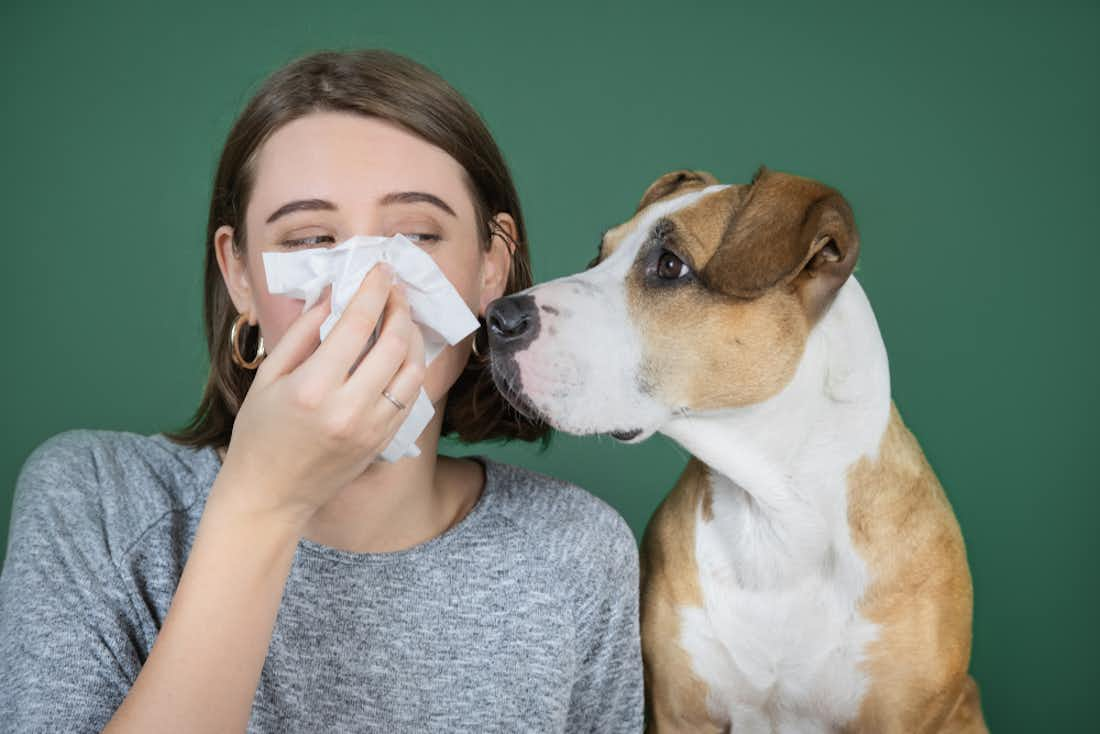Jul 11, 2022
How To Read Allergy Skin Test Results
minute read
Even though allergies and the common cold carry a ton of symptom similarities, we can’t help but feel like allergies are the worse of two evils. It’s because a common cold goes away in just a few days, but allergies can persist for as long as you’re exposed to the substance.
It might be easy to avoid the food you’re allergic to, but it can be nearly impossible to avoid unseen triggers like dust mites or pollen. And if the force that’s stuffing your nose and scratching your eyes is entirely invisible, how are you supposed to avoid it?
Well, the first step is to know exactly what’s causing it, and this can only truly be done with an allergy test. But before you take out the textbooks and start cramming the night before, know that allergy exams are pretty much the only ones that you can’t fail. In fact, they’ll only help you out in the long run.
There are many different ways to get allergy tested, but skin tests are among the most common. Here’s everything you need to know about skin test exams, as well as how to decipher the results.
What Is an Allergy Skin Test?
Things that cause allergies aren’t actually harmful to your body. But for some people, their immune system becomes over-reactive to certain substances like dust mites or pet dander. Their body perceives these as a threat, deploying mechanisms like sneezing and coughing to try to disperse them.
While there’s a lot more to it than that, an allergy skin test takes this basic foundation and uses it to see which substances are causing an allergic reaction. As the name implies, it’s done on the skin to test if environmental triggers (pollen, dust mites), food allergens, insect venom, or medications may cause a reaction.
But on top of that, it can also show you how severely your body reacts to each substance, which might arguably be more important.
A skin test is a non-invasive procedure that is even safe for most children. First, a small amount of a suspected allergen is placed on the skin. For example, if you think you might be allergic to eggs, an allergist will put a small amount of egg protein onto your skin.
Next, the area is gently punctured with a small, sterile device. The allergist will then check your reaction after 15-20 minutes. For some allergens like penicillin or insect venom, the substance may need to be injected directly into the skin itself. These are sometimes referred to as intradermal tests.
While your allergist will help you read through the results, it can still be helpful to know how to understand them going in. Plus, you’ll be able to earn some brownie points with your doctor.
How To Read Skin Allergy Test Results
Skin tests use some visual cues on your skin to show you if you’ve gotten a reaction.
A wheal indicates a positive skin test result. And while this one won’t help your car move along the road, it will look like a raised, red bump on your skin. It might also be itchy or cause a little bit of pain. In general, the larger the wheal, the more allergic you are to the substance. But keep in mind that’s not always the case. If no wheal appears, likely, you do not have an allergy to the suspected substance.
If the skin test is positive, meaning you got yourself a little bumpy wheal, it means that you have a type of antibody known as IgE (Immunoglobulin E). This is an antibody that your immune system produces when you have an allergic reaction to something. This is essentially what all allergy tests are looking for.
Remember that allergy tests are just one part of diagnosing allergy symptoms, and there are other factors involved. Your medical history is considered, including previous reactions to certain substances, medications you’re currently taking, and even family history of allergic reactions.
If your test reads inconclusive for some reason, an allergist may use some of these clues to help fill in the blanks.
What Does a Positive Result Mean?
Receiving a positive test result may not mean that you need to altogether avoid the allergen trigger for the rest of your life. In some cases, people can live healthy and comfortable lives despite exposure to their triggers.
A positive test result is mainly helpful because it allows you to pinpoint and avoid the allergen when possible. For instance, if you find out that you’re allergic to pollen, you can then start trying to avoid going outside on days where pollen counts are high. If you find out you’re allergic to dust mites, it might be time to wash your bedsheets.
Your allergen may also suggest taking medications such as antihistamines to help ease the symptoms of mild allergic reactions. These are especially helpful for environmental allergens like mold or ragweed that are more difficult to avoid than food or contact allergies.
Finally, allergy shots or another form of immunotherapy may be recommended to dilute the underlying causes of your allergies, rather than just the symptoms.
Immunotherapy works by gradually exposing you to an allergen over time so that your body can adjust. Sublingual immunotherapy is an FDA-approved method that requires nothing more than a tablet under your tongue over some time.
Why get injections when it’s as simple as that. Cleared makes fighting back against allergies quick, painless, and inexpensive with the lowest co-pay on the market. If you’d like to find out if immunotherapy is right for you, take our free quiz.
Preparing for a Skin Test
To obtain as accurate test results as possible, it’s important that you prepare properly for your allergy test. For one, you should hold off on taking antihistamine medications for up to 2-5 days before your test. Check with the doctor's office you plan to visit to see how long they want you to be off of antihistamine medications before your appointment.
This is because antihistamines might lessen the effects of certain allergens and give you a false negative.
Also, you shouldn’t use perfume or lotion in the area of your skin that will be tested. This is typically the back of your arms or on your back. These can affect the way the allergen substance absorbs into your skin.
You may also need to stop taking other medications, like antidepressants, before your allergy skin test. Talk to your doctor beforehand, as an alternative allergy test may make more sense.
Are Skin Tests Safe?
Skin tests are generally safe for most people, and they can even be done on children. Your allergist will monitor you the whole time as well, so if something goes wrong, you’ll be in good hands.
Many people who get skin tests say they feel minor discomfort during the prick itself, though it’s a non-invasive procedure that barely breaks the skin. The exposure to the allergen itself might cause you to feel itchy, get watery eyes, or even start sneezing.
In very rare circumstances, an allergy skin test may cause a severe allergic reaction known as anaphylaxis. This is a potentially life-threatening immune system response in which your body releases a flood of chemicals that causes you to go into shock. If this occurs, your allergist can administer a shot of epinephrine and get you emergency care immediately to help stop it.
Also, some skin tests can yield “false positive” results, meaning that the test indicates you are allergic to a substance even when you are not. This is most common when testing with food allergies because the way your body breaks down food proteins in the digestive tract is different from how it breaks down protein on the skin.
For that reason, it may seem like you have an allergy during a skin test even when you’d be able to consume it without a problem.
Skin tests also pose the problem of cross-reactivity, which occurs when foods in a similar family cause a positive reaction even if you’re not actually allergic. For example, green beans contain similar proteins to peanuts and may yield a positive result if you have a peanut allergy. Despite that, you might not actually have an allergic reaction to green beans.
Overall, though, skin tests are a great way to test for reactivity to certain allergens.
Benefits of Skin Tests
Any allergy test is useful for being able to help you identify which substances might cause a reaction and which ones might be generally safe. But on top of that, skin tests carry some benefits that are advantageous over others.
For one, skin tests are extremely fast. In some instances, these allergy tests can detect a positive reaction instantaneously. However, the test usually doesn’t last anywhere longer than 30-40 minutes.
Also, skin tests are pretty painless. The skin prick that occurs doesn’t actually break the skin enough to draw any blood, so you’ll barely feel a thing. This is one of the advantages of skin tests over other ones like blood tests.
With that said, skin tests do yield quite a high number of false positives. In fact, it’s been found that 50-60 percent of skin tests produce false-positive results. Despite that, they are an extremely effective tool in helping to clear up any uncertainty surrounding what is and isn’t causing your allergic reactions.
Who Should Get a Skin Test?
Skin tests are easy and accessible enough so that pretty much anyone who wants one can get one. They’re commonly the first resource used to test for allergen triggers. However, there are instances where it might be more recommended.
An allergy test may recommended if you feel the following symptoms due to an unknown source:
- Abdominal symptoms such as diarrhea or cramping after eating certain foods
- Anaphylaxis or another severe allergic reaction due to foods
- Respiratory symptoms like difficulty breathing or wheezing
- Skin itchiness, rashes, or eczema
Skin tests are especially effective at testing for environmental allergies, food allergies, venom allergies and drug allergies.
Who Shouldn’t Get a Skin Test?
While skin tests are generally safe and effective, there are some circumstances where they may not be appropriate. For one, a doctor might advise against a skin test if you’ve been known to have anaphylaxis in the past.
Additionally, certain medications can interfere with test results, particularly antidepressants or heartburn relief medication. Your doctor may suggest that you continue taking these medications rather than pause their usage in preparation for an allergy test.
Finally, people with certain skin conditions, such as eczema, may not be eligible for a skin test as there is not enough clear area of skin to get an accurate test result.
The good news is that skin tests aren’t the only way to test for allergies. Let’s learn about some other ways to finally understand what’s causing your allergic reactions.
Other Types of Allergy Tests
Skin tests don’t sound like your thing? Have no fear! There are plenty of different allergy tests to choose from that can help show you some of the same information.
Allergy Patch Test
An allergy patch test is a type of skin test that’s even less invasive than a typical skin prick or scratch test. During this test, the allergist will place small patches on your skin that look like bandages. They each contain a small amount of given allergens.
You’ll wear these patches for around 48 to 96 hours before returning to your provider’s office for inspection. If you have rashes, hives, or other reactions, you likely had a positive test result for specific triggers.
These are great because they don’t require a prick of the skin, though they take a lot longer until you get results. Not to mention, they can be uncomfortable to wear for such a long time, and it requires a return visit to your doctor’s office.
Blood Test
If you want to keep your skin in tip-top shape, another way to test for allergies is with a blood test. Additionally, blood tests are great for people where skin tests might not be appropriate. An allergist will draw some blood with a needle for this test and see how it reacts when exposed to suspected allergens.
But why go all the way to the allergist’s office when you can test for 40 indoor and outdoor allergens right from your own home? Cleared’s at-home testing kit lets you become an allergist and do it yourself.
All you’ll do is sanitize a finger on your hand and prick it with the provided device. You’ll drip a few drops of blood onto testing sheets and then send it off to the lab to patiently await your results.
What’s great about blood tests is that they can give you a numerical value for the amount of IgE antibodies in your blood, which will represent both the substances you are allergic to as well as the severity of your reaction.
As their name implies, specific IgE antibody tests can test for several specific different allergens. For example, they can test to see if your blood has a reaction to pollen from walnut trees, birch trees, oak trees, etc., to help you know what you are and are not allergic to.
Provocation Test
If skin tests or blood tests prove inconclusive or ineffective at determining your allergy triggers, a provocation test is often one of the final methods used. With a provocation test, or “challenge” test, a minuscule amount of the suspected allergen is administered orally, through the nasal passages, or inhalation.
These tests require strict observation from a medical professional to provide proper care in the case of anaphylaxis. Often, a hospital stay is necessary to ensure that you do not have a severe reaction over time. So unlike your blood test, this isn’t one you should try doing from home.
Spirometry (Lung Function) Test
A lung function test differs from a typical allergy test because it does not measure what you’re allergic to, nor does it measure for IgE antibodies. Instead, this is a test used for individuals with asthma, a common symptom of allergies.
The test indicates if your symptoms worsen and can also check if inhalers are working as intended.
During the test, you’ll sit upright and place a clip on your nose. Then, you’ll put your lips on a mouthpiece connected to a spirometry machine, where you’ll blow out as hard as you can. This essentially tests to see how well your lungs function.
This test is only performed if you have asthma, difficulty breathing, or wheezing due to an allergy trigger.
Reading Allergy Tests With Cleared
Allergy skin tests involve a tiny prick of the skin, followed by exposure to suspected allergens in the test area. Its goal is to show the severity and type of reaction to certain substances.
If you’re allergic to a substance, it will form a bump called a wheal. Generally, the bigger or itchier the wheal, the more allergic to the allergen you are. This occurs because antibodies in your blood known as IgE antibodies interact with allergens and cause symptomatic reactions.
A reaction indicates a positive test result, but other factors like family history, medical history, and current medications can all play a role. If you find out you’re allergic to something, you’ll likely be advised to avoid the trigger, take antihistamines, or consider immunotherapy.
Finally, if skin tests prove inconclusive or your allergist recommends you try another type of test, there are plenty to choose from. Patch tests, challenge tests, and blood tests are effective and can finally remove the mystery surrounding your stuffy nose.
To save a trip to the allergist and shield yourself from the pollen-filled outside world, meet your online allergist with Cleared. FDA-approved medications, licensed allergists, and personalized therapy have never been so accessible. It’s time to finally take a breath of fresh air.
Sources:
Immunoglobulin E (IgE) Defined | AAAAI
Allergy Skin Test | MedlinePlus
Skin Prick Tests | Food Allergy Research and Education
Authors

Dr. Payel Gupta
Medically reviewed by Dr. Payel Gupta



